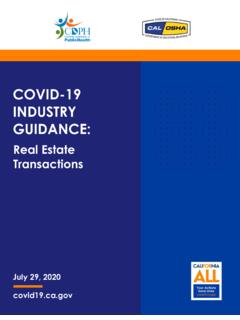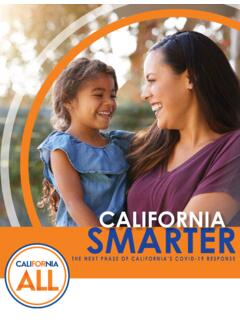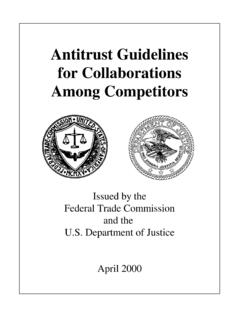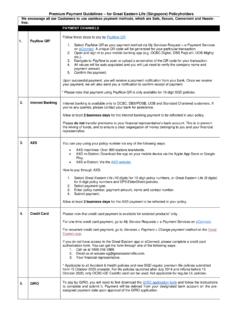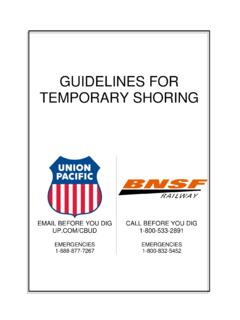Transcription of COVID-19 INDUSTRY GUIDANCE
1 COVID-19 INDUSTRY GUIDANCE : Places of Worship and Providers of Religious Services and Cultural Ceremonies July 29, 1 OVERVIEW On March 19, 2020, the State Public Health Officer and Director of the California Department of Public Health issued an order requiring most Californians to stay at home to disrupt the spread of COVID-19 among the population. The impact of COVID-19 on the health of Californians is not yet fully known. Reported illness ranges from very mild (some people have no symptoms) to severe illness that may result in death. Certain groups, including people aged 65 or older and those with serious underlying medical conditions, such as heart or lung disease or diabetes, are at higher risk of hospitalization and serious complications. Transmission is most likely when people are in close contact or in a poorly ventilated area with an infected person, even if that person does not have any symptoms or has not yet developed symptoms.
2 Precise information about the number and rates of COVID-19 by INDUSTRY or occupational groups, including among critical infrastructure workers, is not available at this time. There have been multiple outbreaks in a range of workplaces, indicating that workers are at risk of acquiring or transmitting COVID-19 infection. Examples of these workplaces include places of worship, hospitals, long-term care facilities, prisons, food production, warehouses, meat processing plants, and grocery stores. As stay-at-home orders are modified, it is essential that all possible steps be taken to ensure the safety of workers and the public. Key prevention practices include: physical distancing to the maximum extent possible, use of face coverings by workers and volunteers (where respiratory protection is not required) and congregants/visitors, frequent handwashing and regular cleaning and disinfection, training workers and volunteers on these and other elements of the COVID-19 prevention plan.
3 In addition, it will be critical to have in place appropriate processes to identify new cases of illness in workplaces and, when they are identified, to intervene quickly and work with public health authorities to halt the spread of the virus. PURPOSE This document provides GUIDANCE for places of worship and providers of religious services and cultural ceremonies (referred to collectively as places of worship ) to support a safe, clean environment for workers, interns and trainees, volunteers, scholars, and all other types of workers as well as congregants, worshippers, visitors, etc. (referred to collectively as visitors or congregants ). This GUIDANCE does not obligate places of worship to resume in-person activity. Further, it is strongly recommended that places of worship continue to facilitate remote 2 services and other related activities for those who are vulnerable to COVID-19 including older adults and those with co-morbidities.
4 Ev en with adherence to physical distancing, convening in a congregational setting of multiple different households to practice a personal faith carries a relatively higher risk for widespread transmission of the COVID-19 virus, and may result in increased rates of infection, hospitalization, and death, especially among more vulnerable populations. In particular, activities such as singing and chanting negate the risk-reduction achieved through six feet of physical distancing. *Places of worship must therefore discontinue indoor singing and chanting activities and limit indoor attendance to 25% of building capacity or a maximum of 100 attendees, whichever is lower. Local Health Officers are advised to consider appropriate limitations on outdoor attendance capacities, factoring their jurisdiction's key COVID-19 health indicators. At a minimum, outdoor attendance should be limited naturally through implementation of strict physical distancing measures of a minimum of six feet between attendees from different households, in addition to other relevant protocols within this revised limitation will be subject to regular review by the California Department of Public Health in consultation with local Departments of Public Health to assess the impact of these imposed limits on public health and provide further direction as part of a phased-in restoration of activities in places of worship.
5 NOTE: This GUIDANCE is not intended for food preparation and service, delivery of items to those in need, childcare and daycare services, school and educational activities, in-home caregiving, counseling, office work, and other activities that places and organizations of worship may provide. Organizations that perform these activities must follow applicable GUIDANCE on the COVID-19 Resilience Roadmap website. The GUIDANCE is not intended to revoke or repeal any worker rights, either statutory, regulatory or collectively bargained, and is not exhaustive, as it does not include county health orders, nor is it a substitute for any existing safety and health-related regulatory requirements such as those of Stay current on changes topublic health GUIDANCE and state/local orders, as the COVID-19 situation continues. Cal/OSHA has more safety and health GUIDANCE on their Cal/OSHA GUIDANCE on Requirements to Protect Workers from Coronavirus webpage. The CDC has additional GUIDANCE for community-and faith-based organizations.
6 Required Use of Face Coverings On June 18, CDPH issued GUIDANCE on the Use of Face Coverings, which broadly requires the use of face coverings for both members of the public and workers in all public and workplace settings where there is a high risk of exposure. People in California must wear face coverings when they are engaged in work, 3 whether at the workplace or performing work off-site, when: Interacting in-person with any member of the public; Working in any space visited by members of the public, regardless of whetheranyone from the public is present at the time; Working in any space where food is prepared or packaged for sale ordistribution to others; Working in or walking through common areas, such as hallways, stairways,elevators, and parking facilities; In any room or enclosed area where other people (except for members of theperson s own household or residence) are present when unable to physicallydistance; Driving or operating any public transportation or paratransit vehicle, taxi, orprivate car service or ride-sharing vehicle when passengers are present.
7 Whenno passengers are present, face coverings are strongly details, including all requirements and exemptions to these rules, can be found in the GUIDANCE . Face coverings are strongly encouraged in other circumstances, and employers can implement additional face covering requirements in fulfilling their obligation to provide workers with a safe and healthful workplace. Employers must provide face coverings to workers or reimburse workers for the reasonable cost of obtaining them. Employers should develop an accommodation policy for any worker who meets one of the exemptions from wearing a face covering. If a worker who would otherwise be required to wear a face covering because of frequent contact with others cannot wear one due to a medical condition, they should be provided with a non-restrictive alternative, such as a face shield with a drape attached to the bottom edge, if feasible, and if the medical condition permits it. Businesses that are open to the public should be cognizant of the exemptions to wearing face coverings in the CDPH Face Covering GUIDANCE and may not exclude any member of the public for not wearing a face covering if that person is complying with the GUIDANCE .
8 Businesses will need to develop policies for handling these exemptions among customers, clients, visitors, and workers. 4 Workplace Specific Plan Establish a written, workplace-specific COVID-19 prevention plan at every location, perform a comprehensive risk assessment of all work areas and all work tasks, and designate a person at each workplace to implement the plan. Incorporate the CDPH Face Covering GUIDANCE into the Workplace Specific Plan and include a policy for handling exemptions. Identify contact information for the local health department where the workplace is located for communicating information about COVID-19 outbreaks among workers and congregants/visitors. Train and communicate with workers and worker representatives on the plan and make the plan available to workers and their representatives. Regularly evaluate workplaces for compliance with the plan and document and correct deficiencies identified.
9 Investigate any COVID-19 illness and determine if any work-related factors could have contributed to risk of infection. Update the plan as needed to prevent further cases. Implement the necessary processes and protocols when a workplace has an outbreak, in accordance with CDPH guidelines . Identify close contacts (within six feet for 15 minutes or more) of an infected worker and take steps to isolate COVID-19 positive workers and close contacts. Adhere to the guidelines below. Failure to do so could result in workplace illnesses that may cause operations to be temporarily closed or limited. Topics for Worker and Volunteer Training Information on COVID-19 , how to prevent it from spreading, and which underlying health conditions may make individuals more susceptible to contracting the virus. Self-screening at home, including temperature and/or symptom checks using CDC guidelines . The importance of not coming to work or participating in activities o If a worker has symptoms of COVID-19 as described by the CDC, 5 such as a fever or chills, cough, shortness of breath or difficulty breathing, fatigue, muscle or body aches, headache, new loss of taste or smell, sore throat, congestion or runny nose, nausea, vomiting, or diarrhea, OR o If a worker was diagnosed with COVID-19 and has not yet been released from isolation, OR o If within the past 14 days, a worker has had contact with someone who has been diagnosed with COVID-19 and is considered potentially infectious ( still on isolation).
10 To return to work after a worker receives a COVID-19 diagnosis only if 10 days have passed since symptoms first appeared, their symptoms have improved, and the worker has had no fevers (without the use of fever reducing medications) for the last 72 hours. A worker without symptoms who was diagnosed with COVID-19 can return to work only if 10 days have passed since the date of the first positive COVID-19 test. To seek medical attention if their symptoms become severe, including persistent pain or pressure in the chest, confusion, or bluish lips or face. Updates and further details are available on CDC s webpage. The importance of frequent handwashing with soap and water, including scrubbing with soap for 20 seconds (or using hand sanitizer with at least 60% ethanol or 70% isopropanol when workers cannot get to a sink or handwashing station, per CDC guidelines ). The importance of physical distancing, both at work and off work time (see Physical Distancing section below). Proper use of face coverings, including: o Face coverings do not protect the wearer and are not personal protective equipment (PPE).




